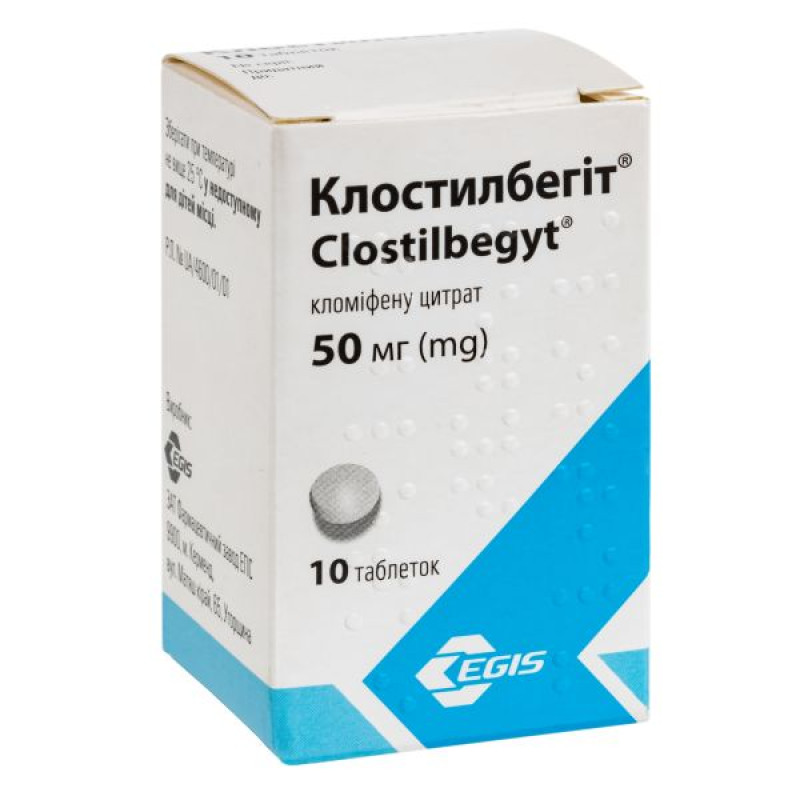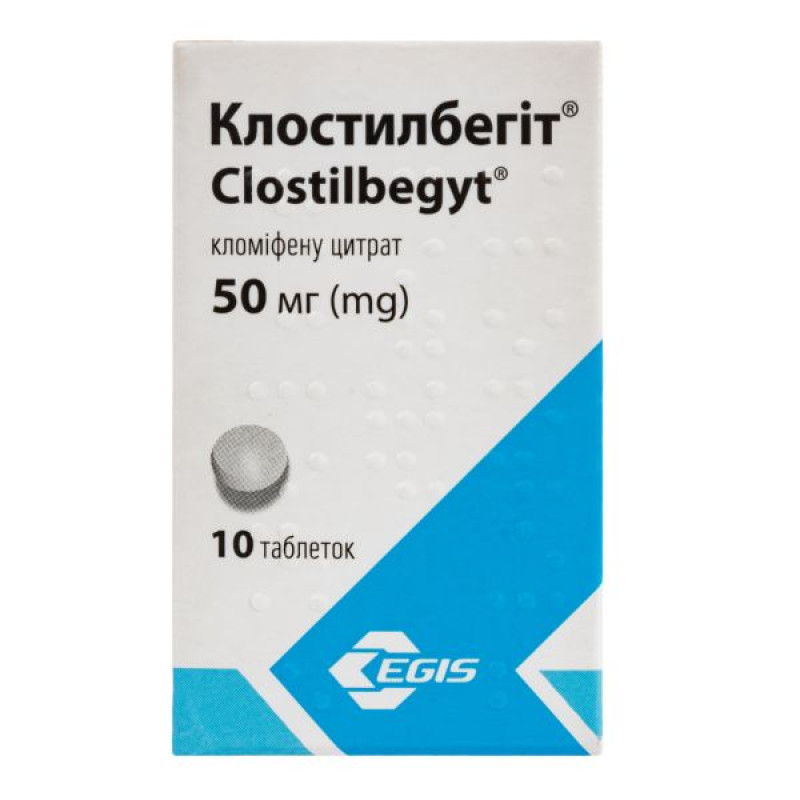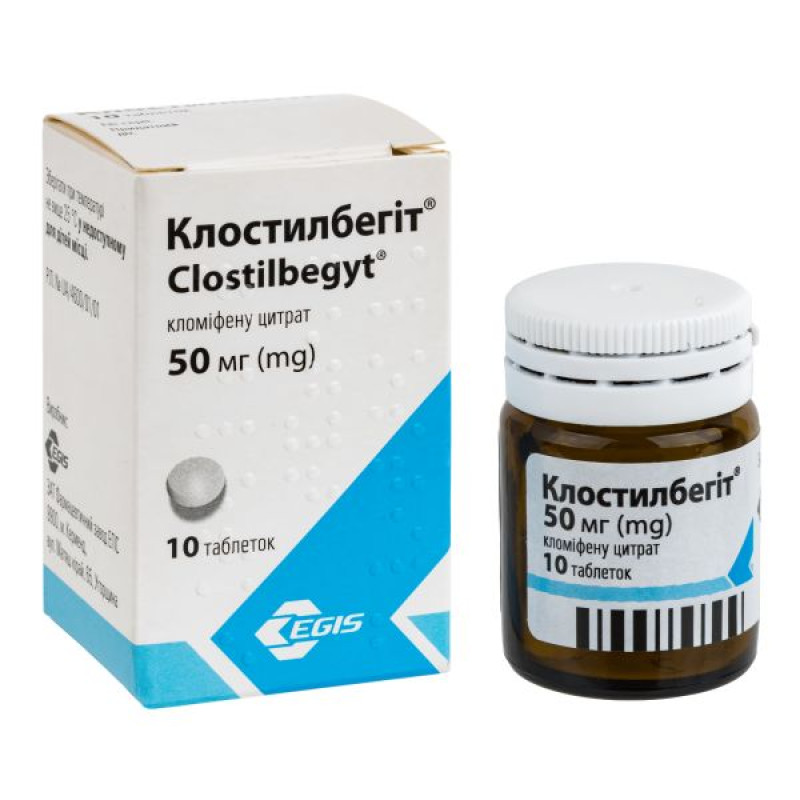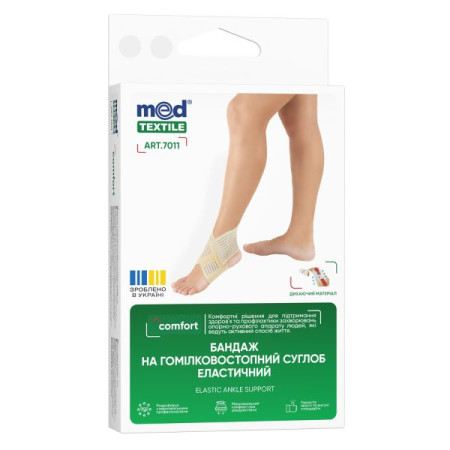Clostilbegit tablets 50 mg bottle #10

Instructions for use Clostilbegit tablets 50 mg bottle No. 10
Composition
active ingredient: 1 tablet contains 50 mg of clomiphene citrate;
excipients: lactose monohydrate, potato starch, talc, magnesium stearate, stearic acid, gelatin.
Dosage form
Pills.
Main physicochemical properties: round, flat tablets with a bevel, engraved with "CLO" on one side, white, yellowish-white or grayish-white in color; odorless or almost odorless.
Pharmacotherapeutic group
Ovulation stimulants, synthetic. ATX code G03G B02.
Pharmacological properties
Pharmacodynamics
Clomiphene is a non-steroidal antiestrogen that stimulates ovulation. The mechanism of action is explained by the ability to specifically bind to estrogen receptors in the hypothalamus and ovaries. In small doses, the drug enhances the secretion of gonadotropic hormones (prolactin, follicle-stimulating and luteinizing) and stimulates ovulation. In large doses, the drug inhibits the secretion of gonadotropins. It does not exhibit gestagenic and androgenic activity.
Pharmacokinetics
After administration, it is completely absorbed from the digestive tract. It is metabolized in the liver. It is excreted mainly with bile, is subject to enterohepatic recirculation and is excreted mainly with feces. The half-life is 5-7 days.
Indication
Treatment of ovulation disorders, including induction of ovulation in women with anovulatory cycles in order to become pregnant. Secondary amenorrhea of various etiologies (including amenorrhea after the use of contraceptives). Stein-Leventhal syndrome. Oligomenorrhea. Chiari-Frommel syndrome (prolonged postpartum amenorrhea-galactorrhea syndrome). Oligospermia.
Contraindication
Hypersensitivity to the active substance or to any other component of the drug. Liver disease or liver dysfunction in history. Ovarian cyst (except polycystic ovary syndrome). Decreased pituitary function. Functional disorders of the thyroid or adrenal glands. Uterine bleeding of unknown etiology. Hormone-dependent tumors. Visual impairment (recent or chronic visual impairment). Pregnancy. Patients with ovarian dyskinesia, during menopause or with other conditions in which the drug cannot be used.
Interaction with other medicinal products and other types of interactions
Not installed.
Application features
Before starting treatment, it is recommended to check liver function, hormonal status and gonadotropin levels in renal excretion, and to conduct a thorough gynecological examination. The use of the drug is recommended only in cases where the level of total urinary gonadotropin is below the lower limit of normal or is normal, when the ovaries are palpated of normal size and the function of the thyroid gland and adrenal glands is normal.
In the absence of ovulation, other possible causes of infertility should be excluded and corrected before starting clomiphene therapy. If ovarian enlargement or cystic transformation is observed, treatment with the drug is not allowed until the ovaries return to normal size. Subsequently, the dose or course of treatment should be reduced.
During treatment, the ovaries should be examined regularly.
During treatment with Clostilbegit®, it is very difficult to determine the time of ovulation and, as a result, insufficient corpus luteum release is often observed, therefore it is recommended to start prophylactic treatment with progesterone after conception.
The drug must be used under the constant supervision of a gynecologist!
Reservation.
A good level of endogenous estrogen (based on assessment of vaginal smears, endometrial biopsy, urinary estrogen levels, or progesterone-induced endometrial bleeding) provides a favorable prognosis for ovulation while taking Clostilbegit®.
Low estrogen levels, although clinically less beneficial, do not preclude a successful outcome of therapy. Clostilbegit® therapy is ineffective in patients with primary pituitary or ovarian insufficiency. Clostilbegit® therapy cannot replace specific treatment in other cases of ovulatory dysfunction, such as thyroid or adrenal disease.
There is another effective treatment for hyperprolactinemia. Clostilbegit® is not the first choice for the treatment of low weight associated with amenorrhea, infertility, and it is not dependent on the high levels of FSH (follicle-stimulating hormone) that are observed during early menopause.
Ovarian hyperstimulation syndrome (OHSS).
Ovarian hyperstimulation syndrome has been reported in patients taking clomiphene to enhance ovulation.
Ovarian hyperstimulation syndrome has been observed after cyclic administration of clomiphene or when used in combination with gonadotropin.
The following syndromes have also been reported to be associated with this syndrome during clomiphene therapy: exudative pericarditis, anasarca, hydrothorax, acute abdomen, renal failure, pulmonary edema, ovarian hemorrhage, deep vein thrombosis, ovarian torsion, and acute respiratory distress syndrome.
The doctor may reduce the dose of the drug or prescribe it for only a short time.
Treatment should be carried out using the minimum effective doses of the drug. It is not recommended to conduct more than 6 courses.
Patients should be warned about the need to inform the doctor about the appearance of pain in the lower abdomen or pelvis, weight gain, discomfort after using the drug. In case of pain in the lower abdomen while taking clomiphene, a careful examination of the patient is necessary and, if ovarian enlargement is detected, treatment should be stopped until the size of the ovaries normalizes. In such cases, the dose and duration of use of the drug during the next cycle should be reduced.
Some patients with polycystic ovary syndrome are sensitive to gonadotropin and may therefore be more sensitive to usual doses of Clostilbegit®.
Patients who also complain of abdominal or pelvic pain, discomfort, or bloating after taking clomiphene should be evaluated for the possibility of cysts or other conditions.
Most patients should be treated conservatively. The dose and/or duration of the next course of treatment should be reduced.
Visual impairment.
Patients should be warned about the occurrence of vision problems such as blurred vision or other symptoms such as spots or flashes (flickering scotoma) that occur during or shortly after stopping treatment with Clostilbegit®.
Visual disturbances are usually reversible; however, cases of persistent visual disturbances have been reported, including after discontinuation of treatment.
Visual impairment may be irreversible, especially when using high doses or during long-term treatment.
The nature of the visual impairment is not understood. However, if the patient develops any symptoms, treatment should be discontinued and a thorough examination by an ophthalmologist should be performed.
Patients should be warned about these symptoms and that they should not drive or operate machinery if they experience them, especially when the lighting changes.
In case of visual impairment, Clostilbegit® should not be prescribed again.
Excipients.
Clostilbegit® contains lactose, therefore patients with hereditary galactose intolerance, lactase deficiency or glucose-galactose malabsorption should not use this drug.
Precautions.
Hypertriglyceridemia.
Cases of hypertriglyceridemia have been reported in post-marketing studies with clomiphene (see section 4.8). The risk of hypertriglyceridemia may be associated with higher than recommended doses or longer treatment, as well as with pre-existing hyperlipidemia or a family history of the disease.
For such patients, monitoring of triglycerides in blood plasma is prescribed.
Multiple pregnancy.
There is a possibility of an increased incidence of multiple pregnancies during therapy with Clostilbegit®.
Potential complications and risks should be discussed with the patient.
Ectopic pregnancy.
During treatment with the drug, the risk of ectopic pregnancy increases.
There was no information about multiple pregnancies at the same time, including intrauterine and ectopic pregnancies.
Uterine fibroids.
The drug should be used with caution in patients with uterine fibroids due to the possible further growth of the fibroids. Listen
Pregnancy loss and congenital anomalies.
The overall incidence of reported congenital anomalies during pregnancy associated with drug exposure during pregnancy (pre- or post-conception) during the studies was within the range of that reported in published data for the general population.
Spontaneous reports of congenital anomalies, such as a partial neural tube defect that was associated with ovulation, have been reported in the literature as a result of taking Clostilbegit®, but this has not been confirmed by human studies.
The doctor should explain to patients the risks of pregnancy, regardless of whether it occurred with the help of the drug or naturally.
The patient should also be informed of the major risks associated with pregnancy, such as the age of the partners, history of abortions, Rh factor, menstrual problems, history of infertility (regardless of the cause), heart disease, diabetes, exposure to infectious diseases such as rubella, as well as congenital family anomalies and other risk factors that may be relevant to the patient for whom clomiphene is being considered. The drug may be prescribed based on the patient's assessment and after consultation with a geneticist.
Ovarian cancer.
There have been rare reports of ovarian cancer occurring while taking fertility drugs: but infertility is a major risk factor for this disease.
Epidemiological data suggest that long-term use of Clostilbegit® may increase the risk of ovarian cancer. Therefore, the duration of treatment should not be exceeded.
After successfully completing a course of treatment with Clostilbegit®, the doctor may prescribe prophylactic treatment with progesterone.
The drug should be used under the constant supervision of a gynecologist.
Ability to influence reaction speed when driving vehicles or other mechanisms
At the beginning of treatment, temporary visual impairment may occur, in which case you should not drive or operate other machinery.
Use during pregnancy or breastfeeding
The use of Clostilbegit® is contraindicated during pregnancy.
After ovulation induction with clomiphene, certain congenital malformations were observed, but their frequency did not exceed that in the general population (< 1%): congenital heart anomalies, Down syndrome, foot deformity, intestinal malformations, hypospadias.
To avoid accidental ingestion of the drug in the early stages of pregnancy, it is necessary to use ovulation tests before each course of treatment. Also, a pregnancy test should be done before each subsequent course of treatment.
It is not known whether clomiphene passes into breast milk, but the drug may reduce lactation. Therefore, it should be used during breastfeeding only after careful assessment of the risk-benefit ratio.
Method of administration and doses
In case of infertility, the dose and duration of treatment depend on the sensitivity (ability to respond) of the ovaries. In case of regular cyclic bleeding, it is recommended to start treatment on the 5th day of the cycle (or on the 3rd day of the cycle in case of early ovulation if the follicular phase is shorter than 12 days). In patients with amenorrhea, treatment can be started at any time during the cycle.
Treatment regimen I: 50 mg daily for 5 days under the control of ovarian response by clinical and laboratory tests. Ovulation usually occurs between the 11th and 15th days of the cycle. In the absence of ovulation in response to the above treatment, it is necessary to proceed to treatment regimen II.
Treatment regimen II: from the 5th day of the next cycle, administer 100 mg daily for 5 days. If ovulation does not occur during this time, the same treatment (100 mg per day) should be repeated again.
In the absence of ovulation, a three-month break should be taken and another three-cycle course of treatment is recommended. If ovulation does not occur after this, repeated treatment is not recommended. The total dose of the drug during any one cycle should not exceed 750 mg.
For amenorrhea after using contraceptives, the dose is 50 mg per day for 5 days.
Children
The use of Clostilbegit® in children is contraindicated.
Overdose
Symptoms of overdose: nausea, vomiting, vasomotor phenomena, visual disturbances (blurred vision, flashes, scotomas), ovarian enlargement, abdominal pain.
In addition to eliminating the active substance, only supportive therapy can be used in case of overdose.
There are no data on the effectiveness of dialysis for the removal of clomiphene.
Adverse reactions
Nervous system: headache, dizziness, fatigue; exhaustion, convulsions, nervous tension, insomnia, fainting, cerebral circulation disorders, cerebral thrombosis, neurological disorders, disorientation and speech disorders.
On the part of the organs of vision: visual disturbances (photosensitivity, double vision, blurred vision, photophobia, flashes, scotomas); afterimages, cataracts, optic neuritis; scotoma, phosphenes (flashes), decreased visual acuity.
From the digestive tract: vomiting, nausea, "acute abdomen", diarrhea, constipation, abdominal pain, bloating, pancreatitis.
From the hepatobiliary system: abnormal liver function tests, hepatitis, jaundice.
From the side of the cardiac system: tachycardia, palpitations.
On the part of the urinary system: increased frequency of urination.
Skin and subcutaneous tissue disorders: allergic dermatitis, rash, itching, blisters, reversible hair loss; erythema multiforme, ecchymosis, angioedema, alopecia, urticaria.
Metabolic disorders: weight gain or loss, increased appetite, hypertriglyceridemia.
From the vascular system: vasomotor phenomena, hot flashes; cerebral thrombosis.
From the reproductive system and mammary glands: abnormal uterine bleeding, dysmenorrhea, ovarian enlargement, painful menstruation, breast tenderness and discomfort; vaginal dryness; ovarian hyperstimulation syndrome, the appearance or worsening of endometriosis, ectopic pregnancy. The appearance or worsening of hormone-dependent tumors, ovarian cancer have been reported. Intermenstrual spotting or menorrhagia.
Mental disorders: depression, paranoid psychosis.
Hot flashes that occur during treatment stop after the end of treatment. Cystic enlargement of the ovaries may also occur, especially in Stein-Leventhal syndrome. In these cases, the ovaries may enlarge to 4-8 cm, so it is necessary to check the body temperature, and when it becomes biphasic, treatment should be stopped. The likelihood of multiple pregnancy increases.
Pregnancy, postpartum and prenatal period: multiple pregnancy; simultaneous intrauterine and ectopic pregnancy; ectopic pregnancy.
Neoplasms benign, malignant and of unknown etiology (including cysts and polyps):
neoplasms or tumors related to the endocrine system; ovarian cancer.
Side effects are dose-dependent and often occur with high doses and prolonged treatment, as reported in studies.
When treated at recommended doses, adverse reactions are not noticeable and do not affect treatment.
Ovarian enlargement.
When using the drug in recommended doses, ovarian enlargement is not common, although the size of the ovaries may increase with the change in cycle. Similarly, pain in the ovaries may increase with the change in cycle (ovulatory syndrome).
Also, with increasing doses and prolonged treatment, ovarian enlargement may result in the formation of cysts and a lengthening of the luteal phase of the cycle.
Cases of abnormal ovarian enlargement have been observed. In such cases, conservative treatment is recommended for most patients.
Expiration date
5 years.
Storage conditions
Store at a temperature not exceeding 25 °C out of the reach of children.
Packaging
10 tablets in a brown bottle; 1 bottle in a cardboard box.
Vacation category
According to the recipe.
Producer
CJSC Pharmaceutical Plant EGIS.
Location of the manufacturer and its business address
9900, Kermend, 65 Matyás Király Street, Hungary.
There are no reviews for this product.
There are no reviews for this product, be the first to leave your review.
No questions about this product, be the first and ask your question.









